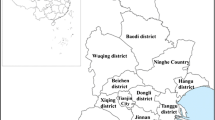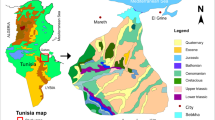Abstract
More than 70 % of Tianjin city’s water supply comes from groundwater. As water demand increases, this reliance on groundwater has caused serious geological problems, such as seawater intrusion. The third aquifer is the main water supply aquifer for Tianjin city. According to supply conditions, water abundance, exploitation conditions, and water quality of the third aquifer, the type of ecological environment system, protection targets and requirements, the present situation of groundwater exploitation and utilization, the groundwater exploitation demand, and utilization for regional water resources allocation as well as national overall scheme about reasonable exploitation, utilization and protection of groundwater resource, groundwater in Tianjin has been divided into seven function areas. After analysis of influencing factors, like water abundance, exploitation intensity and well density, risk factors have been classified using AHP and GIS. Then the comprehensive evaluation model of groundwater exploitation and utilization risks was built. Using this model, the exploitation and utilization risks of the third aquifer in years 2015, 2020, and 2030 have been forecasted. The results show that the risk grade of this aquifer in 2015 is higher than now, while lower in 2020 and 2030. But the risk grade of the 3rd and 4th aquifer increases, since the water yield of this aquifer must still meet a certain amount to support the basic demand of this city.





Similar content being viewed by others
References
Bai XM, Imura H (2001) Towards sustainable urban water resource management: a case study in Tianjin, China. Sustain Dev 9(1):24–35
Dong DL, Wu Q, Zhang R (2007) Environmental characteristics of groundwater: an application of PCA to water chemistry analysis in Yulin. J China Univ Min Technol 17(1):73–77
Dong DL, Sun WJ, Zhang W (2011) Study on infiltration of Tianjin river systems in different typical years based on Mapinfo. The Workshop on Civil Engineering and Energy Engineering (CEEE 2011) July 15th–17th, 2011 in Hohhot, China
Fadlelmawla AA, Fayad M, El-Gamily H, Rashid T, Mukhopadhyay A, Kotwicki V (2001) A land surface zoning approach based on three-component risk criteria for groundwater quality protection. Water Resour Manag 25(6):1677–1697
Fan C, Chen Y-c, Ma H-w et al (2010) Comparative study of multimedia models applied to the risk assessment of soil and groundwater contamination sites in Taiwan. J Hazard Mater 182(1–3):778–786
Feng ZM, Liu DW (2006) A study on water resources carrying capacity in Jingjinji Region. J Nat Resour 5:689–698 [in Chinese]
Hartley WR, Englande AJ Jr, Harrington DJ (1999) Health risk assessment of groundwater contaminated with methyl tertiary butyl ether (MTBE). Water Sci Technol 39(10–11):305–310
Huysmans M, Madarász T, Dassargues A (2006) Risk assessment of groundwater pollution using sensitivity analysis and a worst-case scenario analysis. Environ Geol 50(2):180–193
Milnes E (2011) Process-based groundwater salinisation risk assessment methodology: application to the Akrotiri aquifer (Southern Cyprus). J Hydrol 39(1–2):29–47
Mohammad RN, Mahjouri N (2013) Water quality zoning using probabilistic support vector machines and self-organizing maps. Water Resour Manag. doi:10.1007/s11269-013-0304-5
Nguyen VA, Bang S, Viet PH et al (2009) Contamination of groundwater and risk assessment for arsenic exposure in Ha Nam province, Vietnam. Environ Int 35(3):466–472
Pam MB, Terry PD, Paula AH et al (2003) The sensitivity and vulnerability of terrestrial habitats and species in britain and rreland to climate change. J Nat Conserv 11:15–23
Posen P, Lovett A, Hiscock K et al (2006) Incorporating variations in pesticide catabolic activity into a GIS-based groundwater risk assessment. Sci Total Environ 367(2–3):641–652
Stuart M, Lapworth D, Crane E et al (2012) Review of risk from potential emerging contaminants in UK groundwater. Sci Total Environ 416(1):1–21
Wang XL, Wang HN (2011) Preliminary study on basin water resources allocation methods with water function zone as basic element. Water Resour Protect 27(5):47–51 (in Chinese)
Wang DX, Wang H, Ma J (2000) Water resources supporting capacity for regional development in China. J Hydraul Eng 11:21–26 [in Chinese]
Zhang XH, Zhang HW, Chen B et al (2008) Water resources planning based on complex system dynamics: a case study of Tianjin city. Commun Nonlinear Sci Numer Simul 13(10):2328–2336
Acknowledgments
This study was financially supported by the Beijing Natural Science Foundation (8122037), China’s National Natural Science Foundation (41172213, 41272275) and Fundamental Research Funds for the Central Universities (2009QD03), which we gratefully acknowledge.
Author information
Authors and Affiliations
Corresponding author
Rights and permissions
About this article
Cite this article
Dong, D., Sun, W., Zhu, Z. et al. Groundwater Risk Assessment of the Third Aquifer in Tianjin City, China. Water Resour Manage 27, 3179–3190 (2013). https://doi.org/10.1007/s11269-013-0342-z
Received:
Accepted:
Published:
Issue Date:
DOI: https://doi.org/10.1007/s11269-013-0342-z




